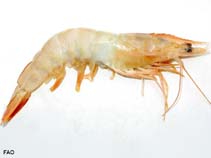Penaeus setiferus (Linnaeus, 1767)
Northern white shrimp
Classification / Names Common names | Synonyms | CoL | ITIS | WoRMS
Malacostraca | Decapoda | Penaeidae
Environment: milieu / climate zone / depth range / distribution range Ecology
Benthic; brackish; depth range 0 - 119 m (Ref. 356). Subtropical, preferred 24°C (Ref. 107945); 40°N - 18°N, 97°W - 74°W
Distribution Countries | FAO areas | Ecosystems | Occurrences | Introductions
Western Atlantic: from New Jersey, USA to Yucatan, Mexico.
Length at first maturity / Size / Weight / Age
Maturity: Lm ?, range 17 - ? cm Max length : 22.4 cm TL male/unsexed; (Ref. 109188); 20 cm TL (female); max. reported age: 2.00 years (Ref. 109223)
Maximum total length of unsexed and female from Ref. 109188 and Ref. 8, respectively. Maximum standard length: 19.0 cm. Maximum depth from Ref. 108758.
Life cycle and mating behavior Maturity | Reproduction | Spawning | Eggs | Fecundity | Larvae
Life cycle: Eggs hatch into planktonic nauplii. The larvae undergo five nauplial, three protozoeal, and three mysis stages; then into two postlarval stages (Refs. 254, 79469). Mating behavior: Precopulatory courtship ritual is common (through olfactory and tactile cues); usually indirect sperm transfer (Ref. 833). Copulation occurs when the male attached its spermatophore to the thelycum of the female (Ref. 109188). Spawning may occur once or up to four times (Ref. 109189).
Main reference
References | Coordinator | Collaborators
Holthuis, L.B. 1980. (Ref. 8)
IUCN Red List Status (Ref. 130435: Version 2024-1)
CITES status (Ref. 108899)
Not Evaluated
CMS (Ref. 116361)
Not Evaluated
Threat to humans
Human uses
Fisheries: commercial; aquaculture: experimental
FAO - Aquaculture: production; Fisheries: landings, species profile | FishSource | Sea Around Us
Tools
More information
Trophic Ecology
Ecology
Population dynamics
Distribution
Human Related
Aquaculture profile
Stamps, Coins Misc.
Stamps, Coins Misc.
Outreach
Taxonomy
References
Internet sources
BHL | BOLD Systems | CISTI | DiscoverLife | FAO(Fisheries: species profile; publication : search) | Fishipedia | GenBank (genome, nucleotide) | GloBI | 1 GoMexSI (interaction data) | Google Books | Google Scholar | Google | PubMed | Tree of Life | Wikipedia (Go, Search) | Zoological Record
Estimates based on models
Preferred temperature
(Ref. 115969): 15.3 - 27.3, mean 24.3 (based on 338 cells).
Resilience
(Ref. 69278):
High, minimum population doubling time less than 15 months (K=1.25-9.8; tmax=2).
Prior r = 0.53, 95% CL = 0.35 - 0.80, Based on 2 full stock assessments.
Nutrients : Calcium = 109 [35, 184] mg/100g; Iron = 1.59 [1.21, 1.97] mg/100g; Protein = 20.2 [19.2, 21.3] %; Omega3 = 0.285 [0.185, 0.386] g/100g; Selenium = 48.3 [-31.7, 128.3] μg/100g; VitaminA = 0 μg/100g; Zinc = 1.79 [1.17, 2.40] mg/100g (wet weight); based on nutrient studies.



